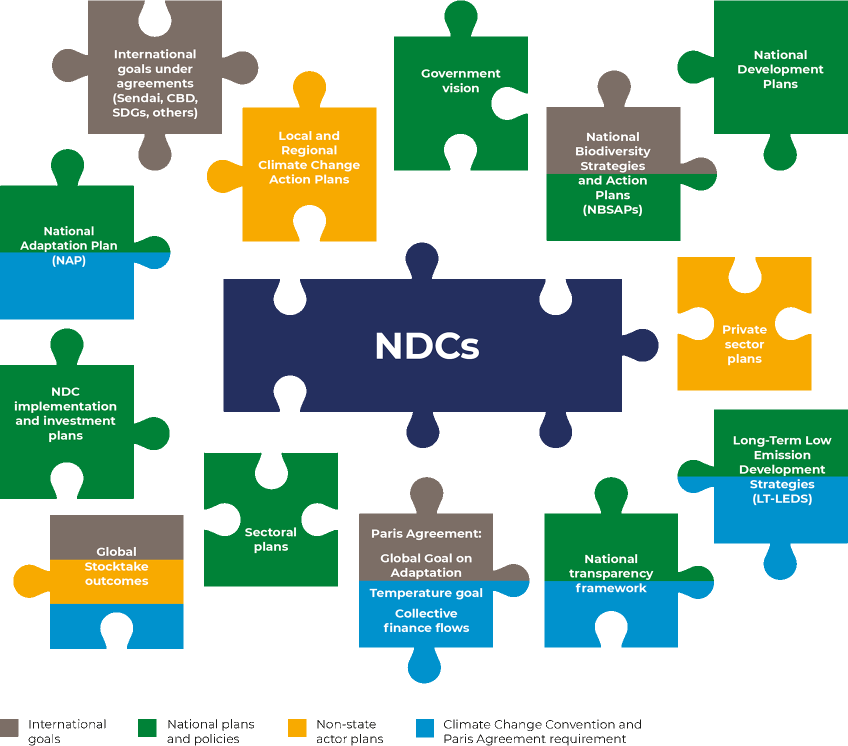Introduction
The NDC 3.0 Navigator is intended to help countries identify opportunities to raise ambition in their NDCs 3.0, which are to be submitted by February 2025 in accordance with Decision 1/CP.21, and Article 4.9 of the Paris Agreement. It sets out examples of impactful opportunities to consider, anchored in national sustainable development priorities, Paris Agreement goals, and the first Global Stocktake outcome. These examples help ensure that climate change responses are leaving no one behind, and help enhance processes that will accelerate implementation, including engaging All-of-Government and Society, and unlocking finance.
About the NDC 3.0 Navigator
The NDC 3.0 Navigator establishes a framework, drawing on the latest science and informed by the outcome of the first Global Stocktake. It provides easy-to-understand summary information and a non-exhaustive menu of options that can be considered by countries to enhance ambition and accelerate implementation. These are complemented by case studies showing practical application, with links to further relevant guidance, resources, and support that may be explored. As a living tool, it will be expanded and updated over time as new knowledge and experience become available.
How is the NDC 3.0 Navigator structured?
The NDC 3.0 Navigator presents seven ‘Routes to ambitious and implementable NDCs’, that users can explore.These encourage reflection on national circumstances and priorities to enhance ambition and accelerate implementation.
Beneath each ‘Route’ are examples of ‘Opportunities’ that could help raise ambition and strengthen implementation in that area. Each Opportunity contains example ‘strategies’ that could provide inspiration for action. Case studies and a set of relevant further resources allow for deeper exploration and guidance.
Structure of the NDC 3.0 Navigator:
- ROUTES
- OPPORTUNITIES
- STRATEGIES
- CASE STUDIES
- FURTHER RESOURCES
- OPPORTUNITIES
How does the NDC 3.0 Navigator address differentiated country needs?
Based on country needs and priorities, guiding questions can help users identify the Routes and Opportunities most appropriate to them, build on previous experience, align with national priorities, and address key ambition and implementation needs to strengthen NDC submissions in 2025.
Who can use the NDC 3.0 Navigator?
The primary audience for the NDC 3.0 Navigator is governments in developing countries and the organizations and individuals who may support them in developing NDCs 3.0. Additional audiences could include anyone looking for information to understand the broader context and opportunities presented by NDCs 3.0.
How does the NDC 3.0 Navigator support NDC development?
Recognizing the substantial work ahead for countries to advance with their NDC 3.0 submissions within a constrained timeframe, this tool aims to assist with the following:
- Identifying opportunities to enhance NDC ambition and supporting processes that work in the national context, reflecting on the previous NDC, implementation progress, and key gaps.
- Contributing to global and collective efforts to implement the outcome of the first Global Stocktake, thereby helping to close the ambition and implementation gaps.
- Supporting NDC implementation through alignment with Sustainable Development Goals (SDGs) and Long-Term Strategies, using Whole-of-Government and Whole-of-Society approaches, and integrating into national, subnational, and sectoral planning, budgeting, and investment processes.
- Emphasizing transparency requirements, including the need for quality documentation and analysis.
- Providing a framework for countries to identify and access support needs for NDCs 3.0 formulation. Numerous Implementing Partners have dedicated programs or resources to support countries in developing their NDCs 3.0, including the NDC Partnership’s Global Call for NDCs 3.0 & LT-LEDS (formerly the Thematic Call on LT-LEDS and NDC Alignment, Update, and Enhancement). The UNFCCC NDC 3.0 landing page also contains links to further guidance and support programs offered by organizations.
Some Routes and Opportunities are specific to supporting alignment to the Paris Agreement Temperature Goal, the Global Goal on Adaptation, and the objective of making financial flows consistent with pathways towards low GHG emissions and climate-resilient development. Other Routes provide examples related to broader and ongoing supporting processes such as governance, finance, or transparency, as well as linkages with wider planning processes, or All-of-Society engagement. These elements could also be considered by countries at any time through the NDC process, including leading up to the submission of NDCs 3.0 and at any time between submissions.
How was the NDC 3.0 Navigator developed?
The NDC 3.0 Navigator is a collaborative tool developed by the NDC Partnership in collaboration with UN Climate Change, supported by UNDP and WRI, and developed by global environmental consultancy Ricardo.
The tool compiles a non-exhaustive set of opportunities, strategies, case studies and guidance gathered through surveys, interviews and engagements with country stakeholders and experts from a wide range of organizations. The needs and challenges for NDCs 3.0, as understood from this stakeholder engagement, have shaped the structure and priorities of the NDC 3.0 Navigator.
The contents have been further developed from stakeholder experiences, countries’ previous NDCs, and supplemented by the landscape review of existing guidance, tools, and case studies.
The NDC 3.0 Navigator aims to be a living tool and will be periodically updated with new and emerging content and examples as knowledge and experience evolve.
Is something missing? Is there a strategy, case study, guidance or tool that would benefit countries’ NDC 3.0 processes? Please let us know here.
Learn
About the context for NDCs 3.0 and the NDC 3.0 Navigator
Reflect
On country needs and priorities for NDC 3.0
Explore
The routes and opportunities to ambitious and implementable NDCs 3.0
The Context for NDCs 3.0
Under the Paris Agreement, the next NDCs (NDCs 3.0) are due by 2025. These NDCs 3.0 will form the basis of countries’ climate commitments moving forward and will be highly important documents for this “critical decade” and beyond. Article 4.3 of the Paris Agreement states that “Each Party’s successive nationally determined contribution will represent a progression beyond the Party’s then current nationally determined contribution and reflect its highest possible ambition, reflecting its common but differentiated responsibilities and respective capabilities, in the light of different national circumstances”. NDCs 3.0 should also drive accelerated implementation of plans, policies, and strategies, and help unlock finance at scale.
The Two Key Needs for NDCs 3.0

From INDCs to NDCs 3.0
The progression of NDCs under the Paris Agreement began with countries submitting their Intended Nationally Determined Contributions (INDCs) following the adoption of the Paris Agreement in 2015. These INDCs reflected countries’ first self-defined national climate pledges under the Paris Agreement. Subsequent submissions, NDC 1.0 and NDC 2.0, necessitated that countries demonstrate progression. Now, the third round of NDCs – NDCs 3.0 – is expected to build upon these previous commitments, demonstrating further clear progression and the highest possible ambition, with the goal of achieving the long-term targets of the Paris Agreement.
The Intergovernmental Process: Decisions Regarding NDCs
Requirements and encouragements for NDCs, as per decisions stemming from the intergovernmental process operating under the Paris Agreement:
- Submission by 2025 (mandatory for all)
- To be submitted 9 to 12 months in advance of COP30/CMA7, i.e. by early February 2025 (Decision 1/CMA.5, paragraph 166)
- To represent a progression beyond the Party’s current NDC and reflect its highest possible ambition (Paris Agreement, Article 4.3)
- Encouragement to incorporate an end date of 2035 (Decision 6/CMA.3)
- Encouragement to incorporate ambitious, economy-wide emission reduction targets, covering all GHGs, sectors, and categories and be aligned with limiting global warming to 1.5 °C, as informed by the latest science, in the light of different national circumstances (Decision 1/CMA.5, paragraph 39)
- Encouragement to be aligned with a country’s Long-Term Low-Emission Development Strategy (LT-LEDS) (Decision 1/CMA.5, paragraph 40)
- To provide the information necessary to facilitate Clarity, Transparency And Understanding (ICTU) and use adopted accounting approaches (mandatory for all) (Decision 4/CMA.1, paragraphs 7 and 13)
- To provide information on how the preparation of the NDC has been informed by the outcomes of the GST (mandatory for all as part of ICTU)
- To provide information on how they contribute towards the Paris Agreement temperature goal and the global emissions trajectory (mandatory for all as part of ICTU)
Outcome of the First Global Stocktake
The Paris Agreement states that countries’ NDCs shall be informed by the outcome of the Global Stocktake.
The Global Stocktake is a process for countries and stakeholders to assess collective progress toward meeting the goals of the Paris Climate Change Agreement – and identify areas needing improvement.
The Global Stocktake takes place every five years, with the first stocktake having concluded at COP28 in 2023.
Its outcome seeks to inform the next round of NDCs under the Paris Agreement, to be put forward by 2025.
Further information on the Global Stocktake process is available here.
The Outcome of the First Global Stocktake (Decision 1/CMA.5) is available here.
Connections Between NDCs and Other National Processes
NDCs 3.0 should build on NDCs 1.0 and 2.0 and take into account the wider policy landscape and country priorities to ensure they become an integrated part of national development and planning activities.
These could include, for example, national development plans, sectoral development plans, Long-Term Low Emission Development Strategies (LT-LEDS), National Adaptation Plans (NAPs), National Biodiversity Strategies and Action Plans (NBSAPs), Voluntary National Reviews (VNRs) of the Sustainable Development Goals (SDGs), National Sustainable Development Strategies, and sectoral, subnational and private sector plans. Integrating climate into development agendas can also ensure social and economic goals are met in a truly sustainable way.
Ensuring climate ambition is based on national priorities will accelerate its implementation. Ensuring that climate priorities are integrated into wider planning avoids, for example, lock-in to unsustainable technologies or processes that impair Development Goals.
Lastly, there is also a critical need to ensure that financing strategies are developed in parallel with the preparation of NDCs, to ensure successful funding and implementation of the NDC.
How NDCs might fit within the domestic policy, legislative and regulatory landscape


